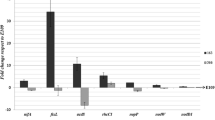Summary
Seedlings ofCasuarina spp. andAllocasuarina spp. were grown from seed in the greenhouse and inoculated with a nodule suspension fromC. equisetifolia. Plants ofCasuarina spp. nodulated regularly and were effective in nitrogen-fixation. Only one species ofAllocasuariona, A. lehmanniana formed root nodules. Using these plants as source of inoculum, the isolation of a newFrankia sp. HFPA11I1 (HFP022 801) was made and the strain was grown in pure culture.Frankia sp. HFPA11I1 grows well in a defined medium and shows typical morphological characteristics. In media lacking combined nitrogen, the filamentours bacterium forms terminal vesicles in abundance and differentiaties large intrahyphal or terminal sporangia containing numerous spores. This strain, used as inoculum, nodulates effectively seedlings ofC. equisietifolia andC. cunninghamiana, forming nodules with verically-growing nodule roots. Although effective in acetylene reduction, the endophyte within the nodules is filamentous and lacks veiscles. When used to inoculated seedlings ofA llocasuarina lehmanniana, Frankia sp. HFPA11I1 induces root nodules which are coralloid and lacking nodule roots. The nodules are effective in acetylene reduction and the filamentous hyphae ofFrankia within the nodule lobes lack vesicles. Effective nodulation inA. Lehmanniana depends upon environmental conditions of the seedlings and proceeds much more slowly than in Casuariana.
Similar content being viewed by others
References
Baker D and Torrey J G 1979 The isolation and cultivation of actinomycetous root nodule endophytes. pp 38–56.In Symbiotic Nitrogen Fixation in the Management of Temperature Forests. Eds. J C Gordon, C T Wheeler and D A Perry. Forest Research Lb. Oregon State Univ., Corvallis.
Baker D, Newcomb W and Torrey J G 1980 Characterisation of an ineffective antinorhizal microsymbiont,Frankia sp. EuI1 (Actinomycetales). Can. J. Microbiol. 26, 1072–1089.
Benson D R, Arp D J and Burris R H 1979 Cell-free nitrogenase and hydrogenase from actinorhizal root nodules. Science 205, 688–689.
Berg H 1983 Preliminary evidence for the involvement of suberization in infection ofCasuarina. Can. J. Bot. 61, 2910–2918.
Burris R H 1974 Methodology. pp 9–33.In The Biology of Nitrogen Fixation. Ed. A Quispel. North-Holland Publ. Co., Amsterdam.
Coyne P D 1973 Some aspects of the autecology ofCasuarina, with particular reference to nitrogen fixation. PhD Thesis, Dept. of Forestry, Australian National University, Canberra, Australia.
Diem H G, Gauthier D and Dommergues Y R 1983a Inoculation ofCasuarine using a pure culture ofFrankia. Nitrogen Fixing Tree Research Reports. 1, 18–19.
Diem H G, Gauthier D and Dommergues Y R 1983b An effective strain ofFrankia from Casuarina sp. Can. J. Bot. 61, 2815–2821.
Hoagland D R and Arnon D I 1950 The water culture method for growing plants without soil. Calif. Agr. Exp. Sta. Cir. 347.
Johnson L A S 1982 Notes on Casuarinaceae. II. Journal of Adelaide Botanic Gardens. 6, 73–78.
Lalonde M 1978 Confirmation of the infectivity of a free-living actinomycete isolated fromComptonia peregrina root nodules by immunological and ultrastructural studies. Can. J. Bot. 56, 2621–2635.
Lealonde M and Calvert H E 1979 Production ofFrankia hyphae and spores as an infective inoculant forAlnus species. pp 95–110.In Symbiotic Nitrogen Fixation ink the Management of Temperate Forest. Eds. J C Gordon, C T Wheeler and D A Perry, Forest Research Lab, Oregon State Univ., Corvallis.
Lechevalier M P, Horrière F and Lechevalier H A 1982 The biology ofFrankia and related organismos. Develop. Ind. Microbiol. 23, 51–60.
Murry M A, Fontaine M S and Torrey J G 1984 Growth kinetics nad nitrogenase induction inFrankia sp. HFPArI3 grown in batch culture. Plant and Soil 78, 61–78.
Murray M A, Fontaine M S and Tjepkema J D 1984 Oxygen protection of nitrogenase inFrankia sp. HFPArI3. Arch. Microbiol. 139, 162–166.
National Research Council 1984 Casuarinas: nitrogen-fixing trees for adverse sites. 118 p. National Academy Press, Washington, D.C.
Tjepkema J D 1978 The role of oxygen diffusion from the shoots and., nodule roots in nitrogen fixation ofMyrica gale. Can. J. Bot. 56, 1365–1371.
Torrey J G 1978 Nitrogen fixation by actinomycete-nodulated angiosperms. Bio Science. 28, 586–592.
Torrey J G 1982 Casuarina: actinorhizal nitrogen-fixing tree of the tropics. pp 427–439.In Biological Nitrogen Fixation Technology for Tropical Agriculture. Eds. P H Graham and S C Harris. CIAT, Cali, Colombia.
Torrey J G 1983 Root development and root nodulation inCasuarina. pp 180–192.In Casuarina Ecology, Management and Utilization. Eds. S J Midgley, J W Turnbull and R D Johnston, CSIRO, Melbourne, Victoria, Australia.
Zhang Z, Lopez M F and Torrey J G 1984 A comparison of cultured characteristics and infectivity ofFrankia isolates from root nodules ofCasuarina species. Plant and Soil 78, 79–90.
Author information
Authors and Affiliations
Rights and permissions
About this article
Cite this article
Zhongze, Z., Torrey, J.G. Studies of an effective strain ofFrankia fromAllocasuarina lehmanniana of the Casuarinaceae. Plant Soil 87, 1–16 (1985). https://doi.org/10.1007/BF02277643
Issue Date:
DOI: https://doi.org/10.1007/BF02277643




